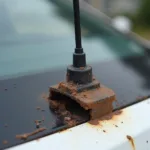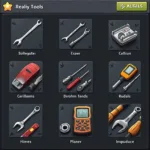Discovering a deep gouge in your car bumper can be frustrating. Whether it’s from a parking mishap, a rogue shopping cart, or an unexpected encounter with a bollard, these unsightly blemishes can detract from your vehicle’s appearance. Fortunately, you don’t always need a professional to fix gouges in your car bumper. With the right tools, techniques, and a bit of patience, you can often repair them yourself and restore your bumper to its former glory. This comprehensive guide will walk you through the steps to effectively repair those pesky gouges.
Assessing the Damage: What You’re Dealing With
Before you start gathering supplies, it’s crucial to assess the severity of the gouge. This will determine the appropriate repair method.
- Minor Gouges and Scratches: These are superficial and haven’t penetrated the bumper’s plastic deeply. They can often be buffed out using polishing compounds.
- Deep Gouges: These have dug into the plastic, requiring filling and repainting for a seamless finish.
- Cracks and Splits: These compromise the bumper’s structural integrity and often need professional attention, especially if the damage extends to the bumper’s mounting points.
DIY Repair for Deep Gouges: A Step-by-Step Guide
For deep gouges that you can tackle at home, follow these steps:
Materials You’ll Need:
- Automotive soap and water
- Clean cloths
- Plastic bumper filler (choose one specifically designed for your bumper type)
- Putty knife or spreader
- Sandpaper (various grits, starting with 180-grit and progressing to finer grits)
- Primer (for plastic bumpers)
- Automotive paint (matching your car’s color)
- Clear coat
- Masking tape and paper
- Safety glasses and gloves
Instructions:
- Clean the Area: Thoroughly wash the damaged area with automotive soap and water to remove dirt, grime, and any loose paint. Allow it to dry completely.
- Apply the Filler: Using a putty knife or spreader, carefully apply the plastic bumper filler to the gouge. Overfill slightly to allow for sanding.
- Let it Cure: Allow the filler to dry and harden completely according to the manufacturer’s instructions. This usually takes several hours.
- Sand it Smooth: Start with a coarse-grit sandpaper (around 180-grit) to shape the filler and level it with the surrounding bumper surface. Gradually progress to finer grits (320, 400, 600) to achieve a smooth and even finish.
- Clean Again: After sanding, clean the area thoroughly to remove dust and debris.
- Mask the Area: Use masking tape and paper to protect the surrounding areas of the bumper that you don’t want to paint.
- Prime the Surface: Apply a thin, even coat of primer specifically designed for plastic bumpers. This helps the paint adhere properly. Allow it to dry completely.
- Apply Paint: Shake the automotive paint can well and apply thin, even coats, following the instructions on the can. Allow each coat to dry before applying the next.
- Clear Coat: Once the final coat of paint is dry, apply a clear coat to protect the paint and give it a glossy finish.
When to Call in the Pros
While DIY repairs can be effective for minor to moderate gouges, some situations call for professional help:
- Extensive Damage: If the gouge is extremely deep, exposes internal components, or involves cracks that affect the bumper’s structure, it’s best to consult a professional.
- Color Matching Issues: Matching your car’s paint color precisely can be challenging. Professionals have access to color-matching tools and techniques for a seamless blend.
- Lack of Experience: If you’re uncomfortable with the repair process or unsure about your abilities, it’s always wise to seek professional help.
For those located in Birmingham seeking expert assistance, you can find reliable car bumper scuff repair Birmingham services.
Preventing Future Gouges: Tips to Protect Your Bumper
- Park Strategically: Whenever possible, park away from shopping carts, other vehicles, and obstacles that could potentially damage your bumper.
- Use Bumper Guards: Consider installing a bumper guard or protector, especially if you frequently park in tight spaces.
- Be Mindful of Clearance: Pay close attention to your surroundings and ensure you have enough clearance when parking or maneuvering in tight spots.
Conclusion
Gouges in your car bumper can be an eyesore, but they don’t have to be a permanent problem. By following the steps outlined above, you can often repair them yourself and restore your car’s appearance. Remember to assess the damage carefully, gather the right materials, and follow the instructions closely. And if you’re ever in doubt, don’t hesitate to contact a professional for help. For more tips on dealing with different types of bumper damage, check out our guides on how to repair vinyl bumper scrape on car, plastic car bumper scratch repair, and bollard car bumper repair. Remember, with the right knowledge and approach, you can keep your car looking its best for years to come.


